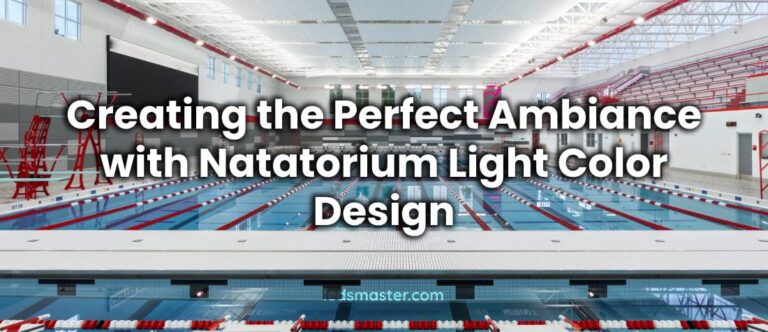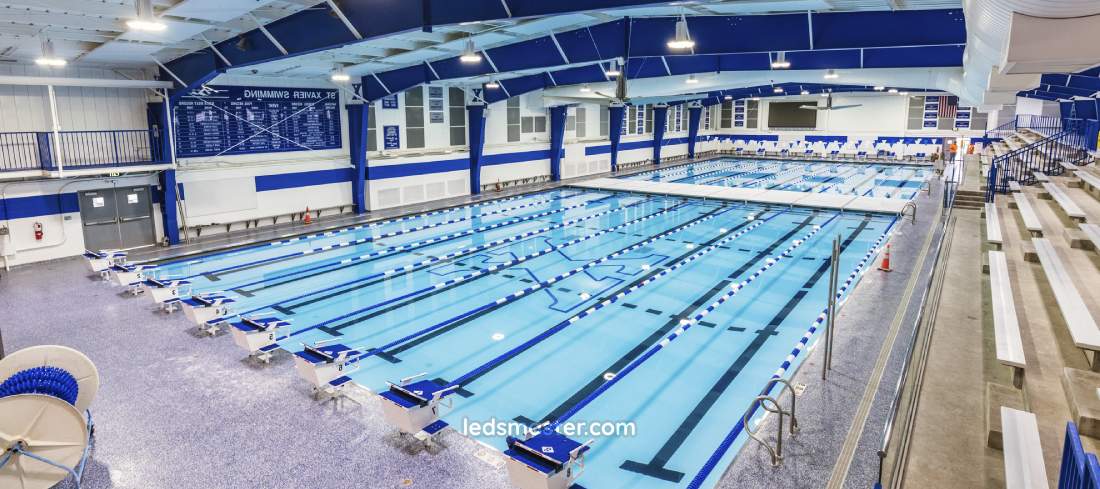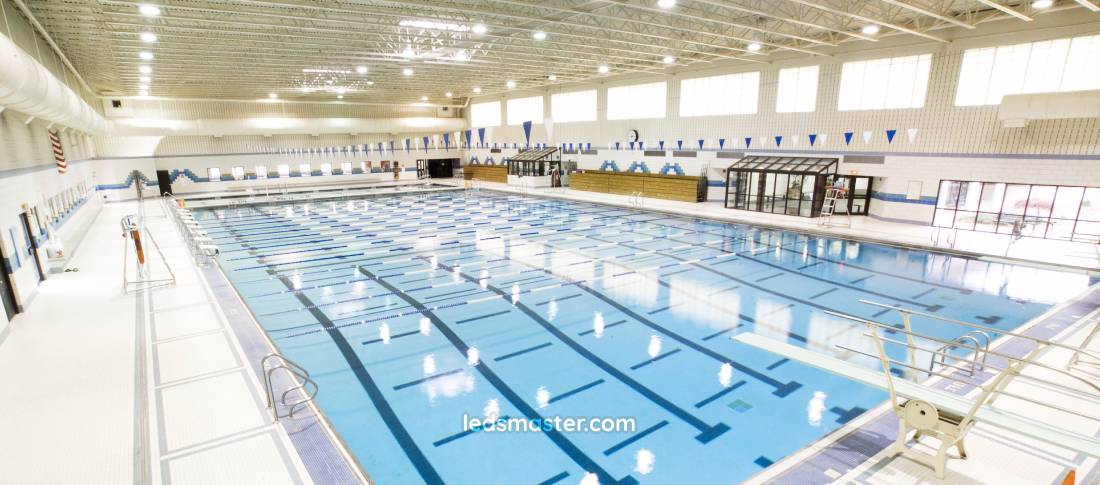
The right lighting not only enhances visibility but also transforms the pool into a dynamic space for athletes and spectators alike. In this guide, we’ll explore how optimal lux levels, uniformity, and lighting techniques can elevate the swimming experience and bring the aquatic environment to life.
Get your complimentary lighting design today
Designing lighting for a natatorium—an indoor swimming pool facility—requires careful consideration of various factors to ensure both functionality and safety. Proper lighting enhances the swimming experience, improves visibility for both swimmers and spectators, and complies with regulatory standards. This article delves into the critical aspects of natatorium lighting design, including general lighting requirements, direct and indirect lighting techniques, and key parameters such as lux levels, uniformity, color rendering index (CRI), and color temperature.
Table of Contents
ToggleIt measures the amount of light falling on a specific area. For natatoriums, the recommended lux levels vary depending on the activities taking place. For general pool areas, a minimum of 200 to 300 lux is typically required to ensure adequate visibility for swimmers. Competitive swimming pools may require higher lux levels, often ranging from 500 to 700 lux, to meet the needs of both athletes and officials during events. Proper illumination not only enhances performance but also ensures safety by minimizing the risk of accidents due to inadequate lighting.

Uniformity in lighting avoid glare and shadows that can interfere with swimming activities. A well-designed lighting system should provide consistent illumination across the entire pool area. Uniformity ratios, which compare the minimum to the average illuminance, should ideally be in the range of 0.7 to 0.8. This ratio ensures that there are no significant dark spots or overly bright areas, which can be distracting or disorienting for swimmers. Achieving good uniformity requires careful placement and selection of light fixtures, as well as proper design of the lighting layout.
The Color Rendering Index (CRI) is a measure of how accurately a light source reveals the true colors of objects compared to natural light. For natatoriums, a high CRI is essential as it ensures that the colors of the water, lane markings, and pool surroundings are perceived accurately. A CRI of 80 or above is generally recommended for swimming pools. This helps swimmers and officials accurately assess visual cues, which is particularly important for training and competitive swimming where precise color differentiation is crucial.
Color temperature, measured in Kelvin (K), affects the overall ambiance and functionality of the lighting. For natatoriums, a color temperature of around 4000K to 5000K is ideal. This range provides a cool white light that mimics natural daylight, creating a bright and refreshing environment. Cooler color temperatures improve visual clarity and reduce eye strain, which is beneficial for both swimmers and spectators. Additionally, the right color temperature contributes to the aesthetic appeal of the facility, enhancing the overall user experience.
Direct lighting involves the use of fixtures that emit light straight onto the pool area and its surroundings. This method is fundamental for providing the intensity of illumination required for safe swimming, lifeguarding, and various recreational activities. The primary objective of direct lighting is to ensure that every area of the pool, including the water surface and surrounding deck, is brightly lit to minimize risks and enhance visibility.
A variety of lighting fixtures are specifically designed to serve as direct lighting sources in natatoriums. Recessed downlights, for example, are installed within the ceiling and provide a direct beam of light downward. These fixtures are excellent for areas requiring focused illumination, such as lane markers in competitive swimming pools or specific features like diving boards. By being flush with the ceiling, they minimize visual clutter and provide a clean, modern aesthetic.
Floodlights, designed to illuminate large areas, produce a broad beam of light. In a natatorium, these fixtures can be strategically positioned around the pool to ensure comprehensive coverage. They are particularly useful for outdoor pools or large indoor swimming areas, where extensive illumination is needed to maintain safety during activities. High-bay LED fixtures are another popular choice, particularly in natatoriums with tall ceilings. These fixtures provide significant light output and can cover expansive areas while being energy-efficient. The use of LEDs not only results in lower energy costs but also decreases maintenance needs due to their long lifespan.
When designing a direct lighting scheme for a natatorium, several considerations must be taken into account to maximize effectiveness and user comfort. The positioning of fixtures is essential in creating effective direct lighting. Careful placement helps avoid issues such as glare and shadows, which can be distracting or hazardous for swimmers. Properly spaced fixtures ensure that light is evenly distributed across the pool surface, eliminating dark spots that could obscure visibility.
Glare can significantly affect a swimmer’s comfort and performance. To minimize glare, fixtures should be angled away from the water’s surface, and the intensity of the light should be managed to create a comfortable environment. Additionally, using fixtures with diffusers can help soften the light output, further reducing harsh glare.
Given the unique environment of a natatorium, characterized by high humidity levels and exposure to chlorine and other chemicals, it is essential to select fixtures that are resistant to moisture and corrosion. Fixtures should be rated for use in damp or wet environments, with protective coatings that prevent degradation over time. This attention to detail ensures longevity and safety. The advantages of direct lighting in a natatorium are manifold.
This is particularly vital for lifeguards who must monitor activities in and around the pool, ensuring a safe environment for all participants. Adequate illumination reduces the risk of accidents. Swimmers can see the edges of the pool and any obstacles, while lifeguards can effectively spot swimmers in distress.
Energy efficiency is another benefit associated with direct lighting. When using LED technology, direct lighting can lead to significant energy savings. LEDs consume less electricity than traditional lighting sources, and their long life reduces the frequency of replacements, contributing to lower maintenance costs over time. In this way, direct lighting not only enhances functionality but also supports sustainable operations.
In contrast to direct lighting, indirect lighting involves the strategic use of fixtures that reflect light off ceilings or walls, creating a soft, diffused glow throughout the natatorium. This approach is valuable for reducing glare and establishing an inviting atmosphere. Indirect lighting enhances the overall aesthetic appeal of the facility while also providing adequate ambient illumination.
A variety of fixtures can be employed for indirect lighting, each contributing to the ambient environment of the natatorium. Wall-mounted fixtures are installed on the walls and can direct light upward or outward. This design allows light to bounce off the ceiling or adjacent surfaces, creating a soft illumination that enhances the overall ambiance of the space. Cove lighting, installed along the edges of ceilings, provides an indirect light source that enhances the architectural features of the natatorium. It produces a uniform glow that fills the space without harsh direct light. This type of lighting is particularly effective in accentuating curves or distinctive architectural elements. Suspended luminaires are another option, hung from the ceiling and designed to direct light upward or downward. When oriented to reflect light off the ceiling, suspended luminaires can create a warm, inviting atmosphere that complements the more focused illumination of direct lighting.
Creating effective indirect lighting in a natatorium involves thoughtful design strategies. Indirect lighting should be distributed evenly throughout the natatorium to avoid dark spots. The arrangement of fixtures should consider the architectural layout and the placement of direct lighting to ensure a cohesive lighting scheme. For a balanced lighting experience, indirect lighting should complement direct lighting. This combination helps to create areas with varying light levels suitable for different activities, from intense swimming competitions to leisurely relaxation. The interplay between direct and indirect lighting can enhance both functionality and aesthetics.
Indirect lighting also provides an opportunity to highlight the architectural beauty of the natatorium. Careful consideration of fixture placement can accentuate elements such as vaulted ceilings, decorative walls, or entryways, contributing to the overall design narrative of the space. The benefits of indirect lighting are numerous and serve to enhance the natatorium environment. One of the most significant advantages of indirect lighting is its ability to minimize glare. By bouncing light off surfaces, it creates a gentle illumination that is easier on the eyes, improving comfort for both swimmers and spectators. The diffused quality of indirect lighting contributes to a more inviting and relaxing atmosphere.
When integrated with energy-efficient fixtures, indirect lighting can also contribute to energy savings. The use of LEDs in indirect fixtures allows for greater efficiency while enhancing the overall aesthetic appeal of the space. By reducing the need for frequent bulb replacements and lowering energy consumption, indirect lighting supports both operational efficiency and environmental sustainability.
The design of lighting systems for natatoriums must take into account several practical considerations to ensure longevity, safety, and efficiency. These factors include moisture resistance, energy efficiency, and maintenance accessibility. Given the constant exposure to high humidity and chemicals in natatoriums, selecting fixtures designed to withstand these conditions is essential. Proper ratings for damp or wet environments will ensure that lighting systems endure the challenges presented by chlorine and moisture. High-quality seals, coatings, and materials can prevent corrosion and degradation, significantly extending the lifespan of the lighting fixtures. By prioritizing moisture resistance, facilities can minimize maintenance needs and operational disruptions.
Energy efficiency is a fundamental aspect of any lighting design, especially in large spaces like natatoriums that require extensive illumination. The choice of energy-efficient fixtures can result in substantial cost savings. LED technology is particularly beneficial, as it offers low energy consumption and a long operational life, reducing the frequency of replacements. Moreover, the integration of smart lighting controls, such as occupancy sensors and programmable dimmers, allows for further energy savings by adjusting lighting levels based on actual use.
Effective maintenance of the lighting system ensure ongoing performance and safety. To facilitate maintenance tasks, the lighting layout should be designed with accessibility in mind. Fixtures should be placed in locations that are easy to reach, allowing for straightforward cleaning, bulb replacements, and repairs. Additionally, choosing fixtures with adjustable components or replaceable parts can further simplify maintenance. A well-maintained lighting system not only ensures consistent light quality but also prolongs the overall lifespan of the fixtures.
The lighting design in a natatorium should not only serve functional purposes but also enhance the aesthetic appeal of the facility. By integrating both direct and indirect lighting, designers can create a cohesive lighting experience that addresses the needs of users while contributing to the overall ambiance. This approach allows for the lighting to support various activities, whether it’s competitive swimming, recreational use, or social gatherings, while ensuring the environment remains inviting and visually appealing.

Achieving a balanced lighting scheme in a natatorium requires careful integration of direct and indirect lighting techniques. Direct lighting ensures that critical areas are well-lit, providing the necessary visibility for swimmers and lifeguards. In contrast, indirect lighting contributes to a softer, more ambient atmosphere, reducing glare and enhancing comfort.
By thoughtfully combining these two approaches, natatoriums can cater to diverse needs. For example, competitive swimming events may benefit from a lighting scheme that prioritizes direct lighting to ensure visibility, while recreational periods can emphasize the more relaxed ambiance created by indirect lighting. The interplay between these two lighting methods can also be adapted to reflect the specific activities taking place, ensuring that the space remains functional and enjoyable for all users.
Implementing a balanced lighting scheme involves strategic planning and execution. Before designing the lighting layout, conducting assessments of the natatorium’s space is essential. This includes evaluating the dimensions, ceiling height, and architectural features that may influence lighting placement and distribution. Once the lighting system is in place, testing various configurations allows for adjustments to be made. This iterative process ensures that both direct and indirect lighting are effectively contributing to the overall illumination while minimizing glare and shadows.
Regular reviews of the lighting system can identify opportunities for upgrades or improvements. Keeping the lighting current with advancements in technology can enhance energy efficiency and improve the quality of illumination over time.
By addressing general lighting requirements such as lux levels, uniformity, CRI, and color temperature, and employing a combination of direct and indirect lighting techniques, designers can create a well-lit space that enhances both the swimming experience and the overall ambiance of the facility. Considering practical aspects like moisture resistance, energy efficiency, and maintenance can further contribute to a successful and sustainable lighting solution. With thoughtful planning and attention to detail, natatorium lighting can significantly improve the quality of the aquatic environment for swimmers, spectators, and facility operators alike.